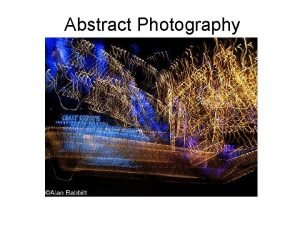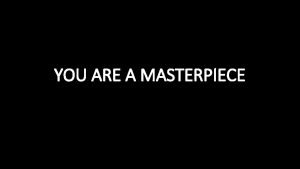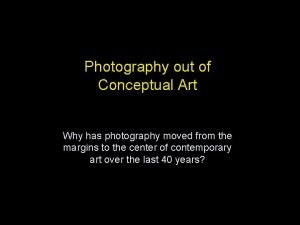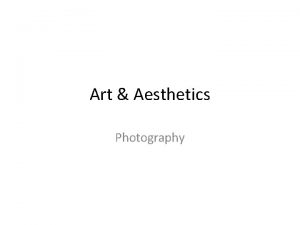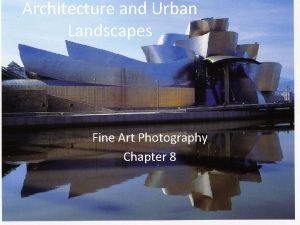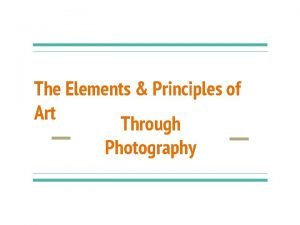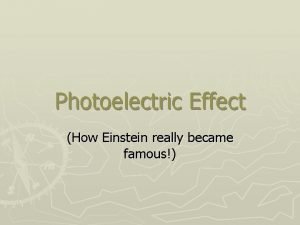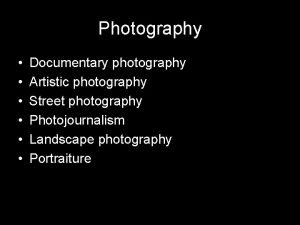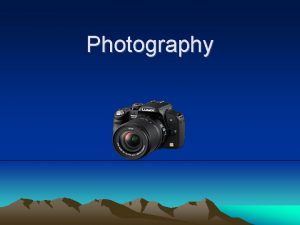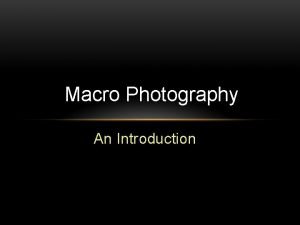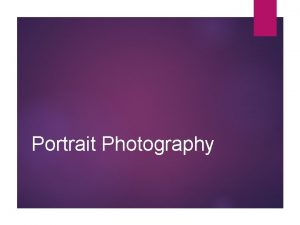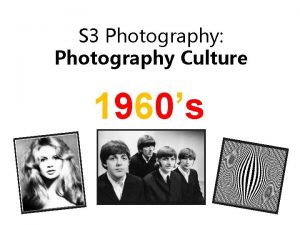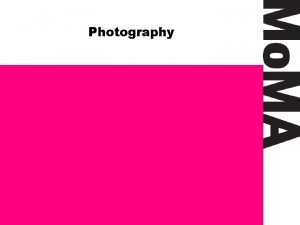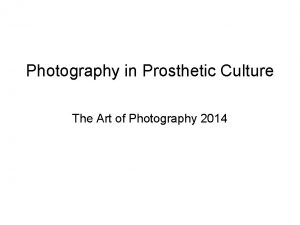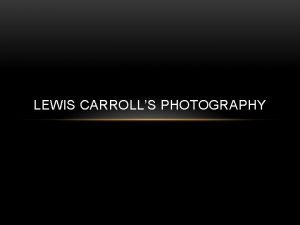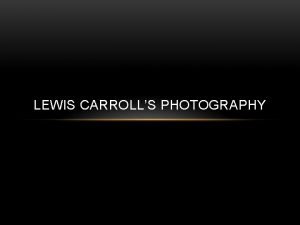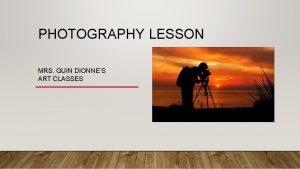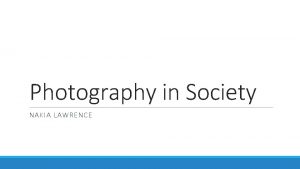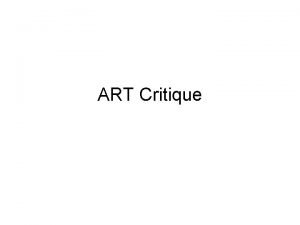Photography Photography The art or process of producing


















































- Slides: 50

Photography

Photography “The art or process of producing images by the action of radiant energy and especially light on a sensitive surface (film). ” Mirriam-Webster Online Dictionary

The Birth of Photography 1. Chinese Philosopher Mo Ti – 5 th B. C. E. Noticed that light passing through a pinhole opening into a darkened chamber forms an exact view of the world outside, but upside down 2. Alhazen – Arab mathematician and physicist, 11 th A. D. Concluded that light travels in straight lines (similar to the human eye) 3. Camera Obscura - Renaissance

Camera Obscura – “Dark Chamber” Used during the Renaissance period.

Camera Obscura – “Dark Chamber”

Pinhole Camera

Other Photographic Inventions 1. Camera Obscura - Renaissance 2. Lens – approx. 1570 3. Daguerreotype - 1837 4. Improved Lenses On optical device that projects an image onto flat surface Help to focus an image projected Preserves an image Reduce exposure time to a fraction of a second

Daguerreotype – 1837 Image is preserved on a light-sensitive surface – a copper plate coated with silver iodide Le Boulevard du Temple, Louise Jacques Mande Daguerre, Daguerreotype, 1839

Daguerreotype – 1837 1 st Commercially viable method for making permanent images from reflected light Photographer Unknown. Daguerreotype of a Couple Holding a Daguerreotype, 1850

First Portable Cameras A camera is a light-tide box with an opening at one end to admit light, a lens to focus and refract the light, and a light-sensitive surface such as film to receive the image and hold it. French Daguerreotype Camera, 1850 (left) / 5 x 7 Eastman View Camera, 1885 (right)

First Lightweight, Handheld Camera 1888 – Invention of Kodak by George Eastman Can be taken anywhere you go!!! Photography becomes a hobby. Kodak Camera & Film, 1888

Mathew Brady - Portrait Photography Lincoln “Cooper Union” Portrait, Mathew Brady, 1860

Julia Margaret Cameron’s Portraits Charles Darwin (left); The Rosebud Garden of Girls (right), Julia Margaret Cameron, 1868

Landscape Photography Ancient Ruins in the Canon De Chelle, Timothy O’Sullivan, 1873 (left) Colorado River From Camp 8, Timothy O’Sullivan, 1871 (right)

Documentary Photography is Born! The Role of Photography: 1. Record events as history is unfolding 2. Document and preserve a visual record of what existed for a time Invention of photomechanical reproduction – high-speed printing of photos and type (1900) gives rise to Photojournalism.

Photography During the Great Depression Migrant Mother, Dorothea Lange, (hired by Farm Security Administration), 1936 (left) Migrant Mother Series, Dorothea Lange, 1936 (right)

Photography and Art “One aspect of photography that some felt stood in the way of making art was its detailed objectivity, which seemed more suited for science. ” Artists tried to make their work look like painting: – – – Created images that looked painterly (blurry, atmospheric, etc. ) Staged things, people to be photographed to resemble a painting Created images by placing objects directly on photographic plates, etc.

Photography and Art Fading Away, Henry Peach Robinson, 1858, Composite print

Tableaux Vivants contained “high art” themes and were designed to resemble classical paintings. Composite Photograph, John P. Morrissey, 1896

Photomontage Technique The technique of making a picture by assembling pieces of photographs, often in combination with other types of graphic material.

How Were Photomontages Made? 1. Composite pictures made by darkroom masking (multiple exposures made onto the same plate, unexposed areas – masked by pieces of black velvet ) 2. Images were created using “cut and paste” technique, than re-photographed 3. Double Exposure 4. Direct contact printing of objects placed on photographic plates

Examples of Photomontage Man With the Rubber Head, Film Still, 1902 German Postcard, Anon, 1902

“Rayograph” images Direct contact printing of objects placed on photographic plates, Man Ray, 1922

“Pure” Photography “For photography to be an art, it must be true to its own nature; it should not try to be painting. ” Alfred Stieglitz - Emphasis on formal values: composition, line, value - Images framed with the viewfinder; not cropped, not manipulated - Composition, tonal values, etc. are visualized in advance

Photography and Art Bridalveil Fall, Ansel Adams, 1960, photographic print (left) Untitled, Alfred Stieglitz, 1924, photographic print (right)

Photography Itself Becomes the Subject Matter As everyday life gets flooded with photographic images which start to compete with direct experience, artists start to examine the role of Photography in society (the particular vision of the world it promotes, and the assumptions we make about it).

What is Photography? Is it a tool for making images or a tool for recording the world?

“Found” Images and Collage Cut With the Kitchen Knife Dada through Germany’s Last Weinmar Beer Belly Cultural Epoch, Hannah Hoch, 1919, collage

Contemporary Photography Untitled #123, Cindy Sherman, 1983 Untitled #209, Cindy Sherman, 1989

Contemporary Photography “I wanted to make something that anyone off the street could appreciate. . . I wanted to imitate something out of the culture, and also make fun of the culture as I was doing it. ” Cindy Sherman Untitled Film Still #14, Cindy Sherman, 1978

Contemporary Photography Binh Dahn http: //www. kqed. org/arts/programs/spark/profile. jsp? essid=7660

Photography & Computer – 1980 s to Present Chtulhu People, Image #d 6, Gulnur Guvenc, Adobe Photoshop

Peter Kennard – London, 1980 s “There is a problem with montage in that you see it everywhere now because of digital technology. There is so much transformed imagery around that people accept constructed images without questioning their meaning. I think my work is losing impact because of that. ” – Peter Kennard, Protect and Survive, 1981 Peter Kennard, Untitled , 1982

Exercises

What is Camera Obscura and how does it work?

What kind of painting technique is this?

What kind of painting technique is this?

What kind of painting technique is this?

What kind of painting technique is this?

2 Categories Which Can Be Applied to Drawing Materials Are:

Film

The Invention of Film 1878 – Eadweard Muybridge – motion studies (series of still images documenting animals and people in motion) Horse Galloping, Eadweard Muybridge, 1878, Collotype

The Invention of Film 1. Film depends on “persistence of vision” phenomenon 2. Celluloid film is invented by George Eastman which allows to string single images together – 1888 3. Thomas Edison creates 1 st motion picture – 1894 4. Brothers Lumiere invent a movie projector - 1895

The Invention of Film 1 st Public Exhibition of a Movie Picture http: //www. youtube. com/watch? v=1 dg. LEDd. Fddk&feature=related

Fantasy and Film Georges Melies, “A Trip to the Moon” – 1902 1 st stop action Sci Fi Movie ever made!!! Incorporates theatrical sets, props, real actors. A Trip to the Moon, Georges Melies, 1902

Movie Studios 1. Studios began to take shape – 1910 s 2. Movies can be produced on a larger scale 3. All aspects of the movie industry are under one roof: directing, producing, writing scripts, filming… 4. A concept of a “Movie Star” is created 5. The job of a Producer becomes increasingly important

One of the 1 st Commercial Films Gone With the Wind, David O. Selznick, 1939, MGM Studios, Hollywood, CA

Filmmaking Vocabulary 1. “Shot” - an unbroken sequence of movie frames 2. “Pan Shot” – camera moving from side to side 3. “Traveling Shot” – camera moving back to front 4. “Cross-Cutting” – two or more shots are alternated to foster the advancement of the story


JR – French graffiti artist, photographer http: //www. ted. com/talks/jr_s_ted_prize_wish_use_art_to_turn_the_world_inside_out. html
 Process specification diagram
Process specification diagram A goal of producing process specifications is to
A goal of producing process specifications is to A goal of producing process specifications is to:
A goal of producing process specifications is to: A goal of producing process specifications is to:
A goal of producing process specifications is to: Is abstract photography same as conceptual photography
Is abstract photography same as conceptual photography Statues of votive figures
Statues of votive figures Elements of art color photography
Elements of art color photography Anselm kiefer heroic symbols
Anselm kiefer heroic symbols Nadar raising photography to the height of art
Nadar raising photography to the height of art Photography art definition
Photography art definition Fine art photography architecture
Fine art photography architecture Elements of art photography
Elements of art photography Edward jenner
Edward jenner An ion source is producing 6li ions
An ion source is producing 6li ions Situation relating question example
Situation relating question example A factory has 20 assembly lines producing
A factory has 20 assembly lines producing Kumar is producing the photoelectric effect by using
Kumar is producing the photoelectric effect by using Seed producing vascular plants
Seed producing vascular plants Producing for dummies
Producing for dummies Gametophytes have gamete-producing organs called _____.
Gametophytes have gamete-producing organs called _____. An individual eats a hamburger. which two systems
An individual eats a hamburger. which two systems Intangible assets on balance sheet
Intangible assets on balance sheet Hình ảnh bộ gõ cơ thể búng tay
Hình ảnh bộ gõ cơ thể búng tay Slidetodoc
Slidetodoc Bổ thể
Bổ thể Tỉ lệ cơ thể trẻ em
Tỉ lệ cơ thể trẻ em Voi kéo gỗ như thế nào
Voi kéo gỗ như thế nào Tư thế worm breton là gì
Tư thế worm breton là gì Chúa yêu trần thế alleluia
Chúa yêu trần thế alleluia Môn thể thao bắt đầu bằng chữ f
Môn thể thao bắt đầu bằng chữ f Thế nào là hệ số cao nhất
Thế nào là hệ số cao nhất Các châu lục và đại dương trên thế giới
Các châu lục và đại dương trên thế giới Công thức tính thế năng
Công thức tính thế năng Trời xanh đây là của chúng ta thể thơ
Trời xanh đây là của chúng ta thể thơ Mật thư tọa độ 5x5
Mật thư tọa độ 5x5 Phép trừ bù
Phép trừ bù Phản ứng thế ankan
Phản ứng thế ankan Các châu lục và đại dương trên thế giới
Các châu lục và đại dương trên thế giới Thể thơ truyền thống
Thể thơ truyền thống Quá trình desamine hóa có thể tạo ra
Quá trình desamine hóa có thể tạo ra Một số thể thơ truyền thống
Một số thể thơ truyền thống Cái miệng nó xinh thế chỉ nói điều hay thôi
Cái miệng nó xinh thế chỉ nói điều hay thôi Vẽ hình chiếu vuông góc của vật thể sau
Vẽ hình chiếu vuông góc của vật thể sau Nguyên nhân của sự mỏi cơ sinh 8
Nguyên nhân của sự mỏi cơ sinh 8 đặc điểm cơ thể của người tối cổ
đặc điểm cơ thể của người tối cổ V cc cc
V cc cc Vẽ hình chiếu đứng bằng cạnh của vật thể
Vẽ hình chiếu đứng bằng cạnh của vật thể Vẽ hình chiếu vuông góc của vật thể sau
Vẽ hình chiếu vuông góc của vật thể sau Thẻ vin
Thẻ vin đại từ thay thế
đại từ thay thế điện thế nghỉ
điện thế nghỉ




